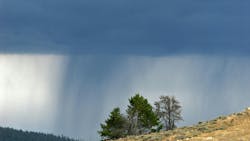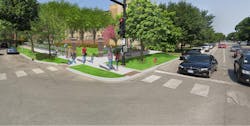Cloudbursts and combination green stormwater infrastructure: How communities can plan for the unexpected
A month's worth of rain in three hours. Flash flooding. Landslides, mudslides and record-breaking precipitation. It might seem like the work of fiction, but these are increasingly common events. Many communities are experiencing extreme, and unexpected, rainfall — more than they ever have before.
Extreme rainfall events are also referred to as “cloudbursts.” They are intense, sudden and localized storms that are becoming more frequent due to climate change. Cloudbursts are common in mountainous areas, such as in the Himalayan regions of India and Nepal, where warm, moist air is pushed upward due to the terrain, creating intense rainfall events that are often concentrated in a small geographic area. As the climate warms, cloudbursts are becoming more common in different locations around the world, including here in North America — from New York to Nova Scotia, to typically sunny California.
Cloudbursts defined
Cloudbursts are causing record-breaking precipitation in a matter of hours and are reshaping the way communities examine their stormwater infrastructure and flood management procedures. With innovative planning and design expertise, communities can better manage extreme weather through resilient stormwater infrastructure. In 2017, the New York Department of Environmental Protection (NYDEP), in partnership with the City of Copenhagen, Denmark, published a Cloudburst Resiliency and Planning Study. Copenhagen utilizes the term “cloudbursts” to describe an event that generates an extreme amount of rainfall in a short period of time. NYDEP adopted this terminology in its own study and resulting Cloudburst Masterplan. This term has become popular when discussing heavy rainfall events in urban environments. Cloudbursts pose challenges for community planners and managers. They can overwhelm existing drainage systems, causing flash flooding, damage to critical infrastructure, and pollution into local waterways and ecosystems. So now that we know cloudbursts are happening more frequently and pose a risk, how can communities prepare and plan for their effects?
Creating cloudburst boulevards
With cloudbursts happening more often, many cities are exploring innovative and resilient stormwater management approaches to reduce vulnerability within their communities and infrastructure. Planning for intense rainfall events requires us to employ a “living with water” approach where vegetated, surface-level stormwater infrastructure is used in combination with larger, strategic storage solutions to capture and detain water during rainfall events. Instead of relying exclusively on underground pipes and reservoirs, communities can integrate natural stormwater management elements that incorporate vegetation and soil to control stormwater on the surface. The goal of this approach is to improve how stormwater is stored and transported on the surface, while also designing urban spaces that are attractive and beneficial for the people, the economy and the environment.
One example of this is to create “cloudburst boulevards” that divert excess water from heavy rainfall events to nearby parks or bodies of water. Such areas offer resilient infrastructure that connects natural habitats and urban settings. These designs are also called blue-green corridors. The corridors manage water and reduce flooding by combining networks of linear water features that support hydrological functions (blue infrastructure) with networks of surface-level vegetated practices that filter and slow the movement of water (green infrastructure).
This sustainable design solution allows cities to restore and manage their natural ecosystems, such as wetlands, forests and grasslands, while protecting against cloudburst events. In terms of the benefits, these nature-based solutions can reduce runoff, increase infiltration, buffer floods, improve water quality and enhance biodiversity. It may take time and significant capital to design and build, but as seen with some of the work being done in this space, the benefits to communities are indisputable.
Different Approaches for Different Communities
The effects of cloudbursts will hit different neighborhoods and cities in different ways. Flooding leaves a mark on the social and emotional well-being of communities. It can affect the sense of belonging and social cohesion of communities. It also causes disruption to normal routines when it comes to access to education, health care, transportation, communication or recreation. This impacts quality of life and opportunities for social interaction and participation during recovery periods.
Not every community will be equally affected by cloudbursts. Communities that are underinvested or are at an economic disadvantage are often located in more flood-prone areas and have fewer resources to cope with and recover from flooding, creating a disproportionate impact. This includes less access to insurance, savings and social networks. Losses from flooding, such as displacement, property destruction, income loss and injury affect these vulnerable communities more intensely.
To address these issues, urban planners and designers need to adopt a holistic and inclusive approach to flood risk management that considers the needs and capacities of different neighborhoods and people.
Chicago offers one such example. In 2018, the Metropolitan Water Reclamation District of Greater Chicago (MWRD) initiated a Stormwater Master Planning Program to address urban flooding problems in Cook County. The areas studied were within lower income neighborhoods that have a high impervious cover and undersized infrastructure, resulting in chronic flooding and basement backups during small rain events. A review of the stormwater system, combined with a strong desire to provide the greatest benefit to the community, resulted in the development of a master plan with recommendations for flood and community resiliency using green stormwater infrastructure, combined with traditional gray infrastructure. With the right infrastructure in place, impacted communities will experience enhanced resiliency through focused investments and projects that employ thoughtful and integrated stormwater management systems.
Bonus: Environmental Benefits
We know that holistic solutions help manage the major effects of cloudbursts. As a bonus, utilizing green stormwater infrastructure when addressing cloudbursts can bring additional benefits to the environment.
First, it can help with water quality. Stormwater runoff from urban areas delivers pollutants, including pathogens, nutrients, bacteria, sediment and heavy metals, to waterbodies. The soil, vegetation and filter media in green stormwater infrastructure removes pollutants and reduces the volume of runoff reaching streams, lakes, and rivers.
Green stormwater infrastructure can also help mitigate flood risk as it slows and reduces stormwater discharge. These systems capture and retain stormwater runoff, allowing it to infiltrate into the ground or evaporate back into the atmosphere. This reduces the volume of stormwater that enters the sewer system, which can prevent sewer backups and reduce the risk of flooding.
These vegetated systems also serve as habitats for birds, insects and other wildlife, increasing biodiversity. In addition, green stormwater infrastructure supports plant growth, which can provide food sources for pollinators and other species.
Lastly, green stormwater infrastructure helps address the “urban heat island effect.” Trees and vegetation in these systems provide shade, reducing the amount of solar radiation absorbed by buildings and other impervious surfaces. Vegetation also releases water vapor through a process called evapotranspiration, which can cool the surrounding air.
Bettering communities with stormwater infrastructure
As the climate is changing and cities are faced with new stormwater challenges such as cloudbursts, communities are investing in resilient infrastructure. They are using innovative stormwater management techniques that integrate traditional gray solutions with green space, while providing impactful dual-use community spaces. Municipalities are employing infrastructure solutions that not only provide flood mitigation, but also consider social and environmental benefits through climate resiliency and adaptation programs. This ensures that future stormwater investments are used in a way that provides the greatest contribution to our communities.
Rebecca Connolly | Water Resources Engineer
Rebecca Connolly is a water resources engineer at Stantec. Connolly can be reached at [email protected].
Bernadette Callahan | Senior Associate, Green Infrastructure Sector Leader, Water
Bernadette Callahan is senior associate and green infrastructure sector leader in water at Stantec. Callahan can be reached at [email protected].







